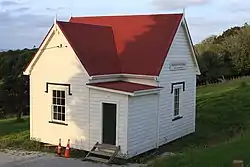Mahurangi West
Mahurangi West is a rural settlement in the Auckland Region of New Zealand. Puhoi is to the west, Mahurangi Harbour is to the east, and the western part of Mahurangi Regional Park is southeast.[3]
Mahurangi West | |
|---|---|
 Mahurangi West Hall, originally Mahurangi Heads West School | |
| Coordinates: 36.503°S 174.694°E | |
| Country | New Zealand |
| Region | Auckland Region |
| Ward | Rodney ward |
| Community board | Rodney Local Board |
| Electorates | |
| Government | |
| • Territorial Authority | Auckland Council |
| Area | |
| • Total | 0.27 km2 (0.10 sq mi) |
| Population (June 2023)[2] | |
| • Total | 150 |
| • Density | 560/km2 (1,400/sq mi) |
Mahurangi Heads West School operated from 1886 to 1946. It was a half-time school for the early part of this period, sharing its teacher with another school. The school building is now Mahurangi West Hall.[4]
Demographics
Statistics New Zealand describes Mahurangi West as a rural settlement, which covers 0.27 km2 (0.10 sq mi)[1] and had an estimated population of 150 as of June 2023,[2] with a population density of 556 people per km2. Mahurangi West is part of the larger Puhoi Valley statistical area.[5]
| Year | Pop. | ±% p.a. |
|---|---|---|
| 2006 | 75 | — |
| 2013 | 72 | −0.58% |
| 2018 | 87 | +3.86% |
| Source: [6] | ||
Mahurangi West had a population of 87 at the 2018 New Zealand census, an increase of 15 people (20.8%) since the 2013 census, and an increase of 12 people (16.0%) since the 2006 census. There were 39 households, comprising 42 males and 45 females, giving a sex ratio of 0.93 males per female. The median age was 57.7 years (compared with 37.4 years nationally), with 12 people (13.8%) aged under 15 years, 9 (10.3%) aged 15 to 29, 36 (41.4%) aged 30 to 64, and 30 (34.5%) aged 65 or older.
Ethnicities were 96.6% European/Pākehā, and 10.3% Māori. People may identify with more than one ethnicity.
Although some people chose not to answer the census's question about religious affiliation, 58.6% had no religion, 34.5% were Christian and 3.4% were Buddhist.
Of those at least 15 years old, 27 (36.0%) people had a bachelor's or higher degree, and 9 (12.0%) people had no formal qualifications. The median income was $25,500, compared with $31,800 nationally. 21 people (28.0%) earned over $70,000 compared to 17.2% nationally. The employment status of those at least 15 was that 21 (28.0%) people were employed full-time, 15 (20.0%) were part-time, and 3 (4.0%) were unemployed.[6]
Notes
- "ArcGIS Web Application". statsnz.maps.arcgis.com. Retrieved 19 May 2022.
- "Subnational population estimates (RC, SA2), by age and sex, at 30 June 1996-2023 (2023 boundaries)". Statistics New Zealand. Retrieved 25 October 2023. (regional councils); "Subnational population estimates (TA, SA2), by age and sex, at 30 June 1996-2023 (2023 boundaries)". Statistics New Zealand. Retrieved 25 October 2023. (territorial authorities); "Subnational population estimates (urban rural), by age and sex, at 30 June 1996-2023 (2023 boundaries)". Statistics New Zealand. Retrieved 25 October 2023. (urban areas)
- Harriss, Gavin (March 2022). Mahurangi West, Auckland (Map). NZ Topo Map.
- "The History of Mahurangi West Hall". Mahurangi West Hall Inc. Retrieved 19 May 2022.
- 2018 Census place summary: Puhoi Valley
- "Statistical area 1 dataset for 2018 Census". Statistics New Zealand. March 2020. 7001314.